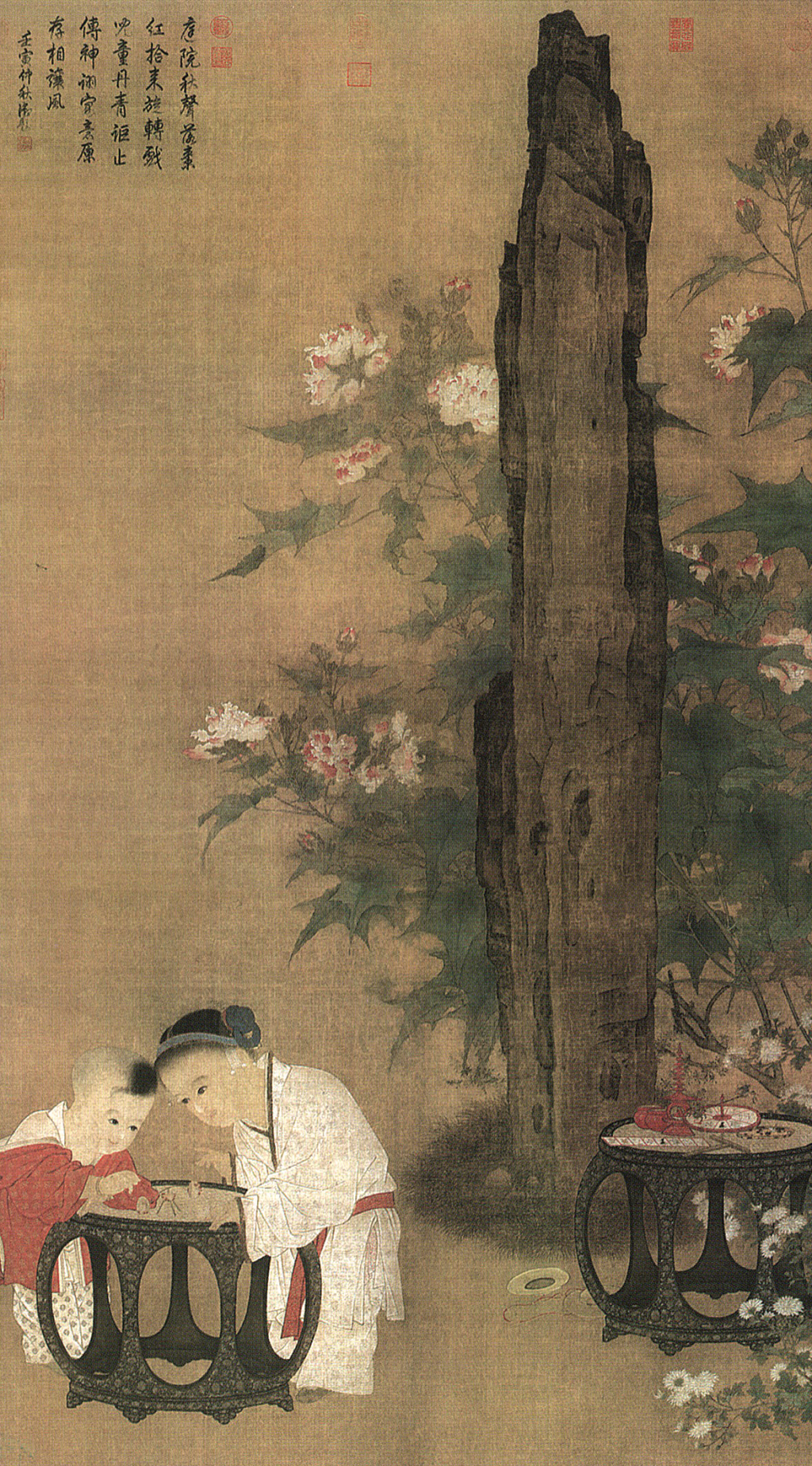
The Southern Song painter Su Hanchen's masterpiece, "Children Playing in an Autumn Courtyard," now in the collection of the National Palace Museum in Taipei, depicts a brother and sister engrossed in a game of grinding dates around small round stools. The stools in the painting are lacquerware furniture popular during the Song Dynasty, inlaid with intricate mother-of-pearl.

Song Dynasty, Su Hanchen, "Children Playing in the Autumn Courtyard", color on silk, length 197.8 cm, width 108.4 cm, collection of the National Palace Museum, Taipei
Throughout the history of Chinese art, raw lacquer has been a distinctive and influential decorative material. Lacquerware, crafted by artisans, has long been a beloved commodity, with the most prestigious being "Zhejiang lacquer," a highly sought-after product. Lacquerware dates back to the primitive Hemudu and Kuahuqiao cultures of northeastern Zhejiang. A vermilion lacquer bowl unearthed at the Hemudu site traces Chinese lacquerware back 7,000 years.
Professor He Zhenji of the China Academy of Art recently published his new book, "The Light of the Lacquer Ancestor: A History of Zhejiang Lacquer Art," by Zhejiang Ancient Books Publishing House. Through a series of iconic artifacts, including the Hemudu lacquer bowl, the Liangzhu lacquer wood goblet, the Yinshan Yuewang Mausoleum lacquerware, the Han Dynasty painted lacquerware, the Tang and Song Dynasty mother-of-pearl and gilt ware, the Yuan Dynasty carved lacquerware, and the Qing Dynasty gold lacquerware, the book reveals the continuous evolution and unique achievements of Zhejiang lacquer art in terms of its technical, aesthetic, and cultural functions. The author also comprehensively examines the status and value of significant existing lacquerware remains.

The Light of the Lacquer Ancestor: A History of Zhejiang Lacquer Art, by He Zhenji, Zhejiang Ancient Books Publishing House

A Northern Song Dynasty sandalwood lacquer-coated, inscribed, and gilded gabled relic casket
In 2019, the Liangzhu Ancient City Site in Zhejiang Province was inscribed on the World Heritage List. In addition to jade ritual vessels such as jade cong and jade bi, Liangzhu culture tombs also saw breakthroughs in the development of lacquerware. Archaeologists have unearthed nearly 100 lacquerware artifacts at more than a dozen sites within the Liangzhu ancient city. Lacquer cups inlaid with jade were discovered at both the Fanshan and Yaoshan sites. These are the earliest known remains of jade-inlaid lacquerware, making them a representative example of Liangzhu culture lacquerware. Furthermore, numerous lacquered stone axes have been discovered at Liangzhu cultural sites, confirming the importance of lacquerware as a ritual vessel.

During the Five Dynasties, a mother-of-pearl inlaid sutra box was unearthed in Feiying Pagoda in Huzhou in 1986. It was a sutra box that Wu Hanyue, the Queen Mother of Shunde of Wuyue State, deposited in Guangfu Jinwenyuan, Tiantai Mountain, in the first year of Guangshun of the Later Zhou Dynasty (951).
The author explains that the circulation and spread of lacquerware from various regions led to an unprecedented level of abundance and development in Zhejiang's lacquerware production during the Song Dynasty, both in terms of quantity and style. By this time, Zhejiang lacquerware had already gained a growing reputation, as can be clearly seen in the numerous Song Dynasty lacquerware artifacts still available today, and even described in relevant literature as "the best in the world."

A carved rhinoceros horn lacquer plate from the Song and Yuan dynasties, 1.5 cm high, 11.1 cm wide, and 22.4 cm long, now in the collection of the Museum of Fine Arts, Boston, USA.

Southern Song Dynasty, a long red box with phoenix patterns, 9.5 cm high, 19.7 cm long, and 12.6 cm wide, collected by the Tokyo National Museum, Japan
He Zhenji's research suggests that in recent decades, archaeological excavations in China have uncovered an increasing number of Song Dynasty lacquerware artifacts. This observation, particularly of artifacts bearing Hangzhou and Wenzhou inscriptions that have been transferred to other regions, demonstrates the crucial role played by the production and dissemination of Zhejiang lacquerware during this period. Furthermore, the fame of "Zhejiang lacquer" stems not only from the profound influence of Zhejiang lacquerware during the Song and Yuan dynasties, but also from the early archaeological discoveries of Zhejiang lacquerware in the late 20th century, most notably the excavation and research of numerous prehistoric lacquerware remains in Zhejiang.

A Southern Song Dynasty mirror-shaped box with carved rhinoceros horn and peony patterns, measuring 26 cm long, 15.5 cm in diameter, and 3.2 cm thick, was unearthed in 2002 from a brick factory in Donghu, Shaoxing. The box is hollow, carved from rhinoceros horn, and has a handle. It features a brown base and a black surface. The entire box is decorated with peony patterns in alternating red, yellow, and black. It contains a copper mirror with a handle, embellished with a double phoenix pattern. The box has a closed rim, with one side completely damaged, leaving only the circular rim.